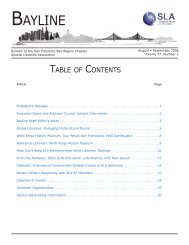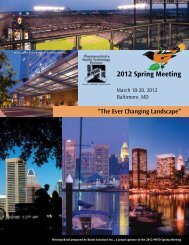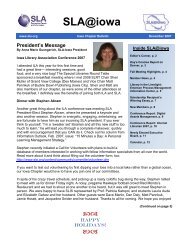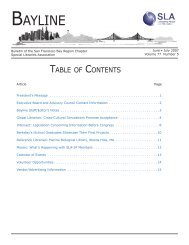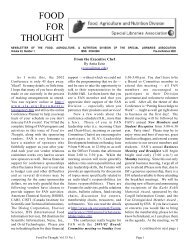Education Libraries - Special Libraries Association
Education Libraries - Special Libraries Association
Education Libraries - Special Libraries Association
Create successful ePaper yourself
Turn your PDF publications into a flip-book with our unique Google optimized e-Paper software.
The traditional view of teaching art is through<br />
lecturing, but clearly that is no longer<br />
considered effective. Why do you think this<br />
change in approach has occurred? What is the<br />
thinking behind waiting until students “ask”<br />
for information – like when the artwork was<br />
painted - before offering it?<br />
Lecturing only reaches a small group of learners,<br />
and is especially unhelpful in the museum setting,<br />
where a group is visiting for the average of an<br />
hour. From almost the beginning of my museum<br />
career, I could see that talking too much put<br />
people off, and really hampered the aesthetic<br />
experience. The Visual Thinking process (VTS) is<br />
dynamic and interesting, and builds off of people’s<br />
responses. All of this is a more pleasurable<br />
process of looking and learning,<br />
and one where information is<br />
retained. When you wait for a<br />
student/visitor to ask for<br />
information, you have found the<br />
teachable moment, and the<br />
information makes sense to<br />
them.<br />
One aspect of the Visual<br />
Thinking Process is that it is<br />
“inquiry-based” which is a<br />
concept that is used in other<br />
teaching areas such as science.<br />
For example, students often<br />
find personal explorations of<br />
nature far more useful than<br />
reading science books. How important is the<br />
inquiry-based aspect to this approach and how<br />
did it come to be used?<br />
Inquiry, or dialogue, is critical to this process. You<br />
can’t do it without asking questions or allowing<br />
your viewers to guide the process, and being able<br />
to respond to the answers. It is a type of Socratic<br />
Dialogue.<br />
In the Henry Art Gallery <strong>Education</strong><br />
Department’s Visual Thinking Curriculum,<br />
students are taught to trust their own<br />
observations and ideas about works of art. How<br />
do you work with students to help them trust<br />
their intuition about what they see? How do<br />
you teach them to “see?”<br />
This is difficult to put into words, but basically,<br />
you allow them to do what they can do. You<br />
choose works that are stimulating to talk about,<br />
and that progress in challenge. You ask for as<br />
much detail as possible, and make them look, and<br />
then look again. As they have success in<br />
unlocking the mysteries of an artwork, they want<br />
to know more, and look more. They begin to trust<br />
themselves.<br />
Can you give me some examples of the<br />
questions you might ask me to guide me to an<br />
understanding of an artwork? Suppose you<br />
used Homer’s The Lifeline, as you did in your<br />
SLA presentation.<br />
The first VTS question is “What do<br />
you see here?” or “What is going on<br />
in this image?” Subsequent questions<br />
build off of the answers, but remain<br />
very simple. Perhaps: what colors,<br />
what lines, what shapes? Then you<br />
build off of the answers.<br />
My understanding is that you ask<br />
the students to articulate their<br />
responses and to find evidence to<br />
support opinions and reasoning.<br />
What might be an example of<br />
evidence to support an opinion<br />
about art?<br />
Students need to describe what they<br />
see and be articulate about the details. They need<br />
to explain their observations based on what is<br />
there, but they may also be creative about<br />
interpretation. VTS does not discourage responses,<br />
or guide the process to a given goal. There is no<br />
goal.<br />
I imagine that you also need to explore<br />
composition, subject matter, medium, and<br />
artist. How do you teach these traditional<br />
aspects of art while you are also doing this<br />
more esoteric type of exploration? And really,<br />
how much does a teacher or librarian need to<br />
know to share art using this method with<br />
others? Do they need all the degrees and<br />
experience that you have?<br />
<strong>Education</strong> <strong>Libraries</strong>, Volume 31, No. 2, Winter 2008 40



